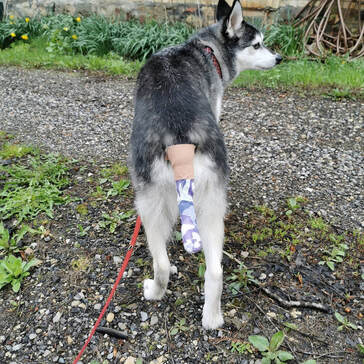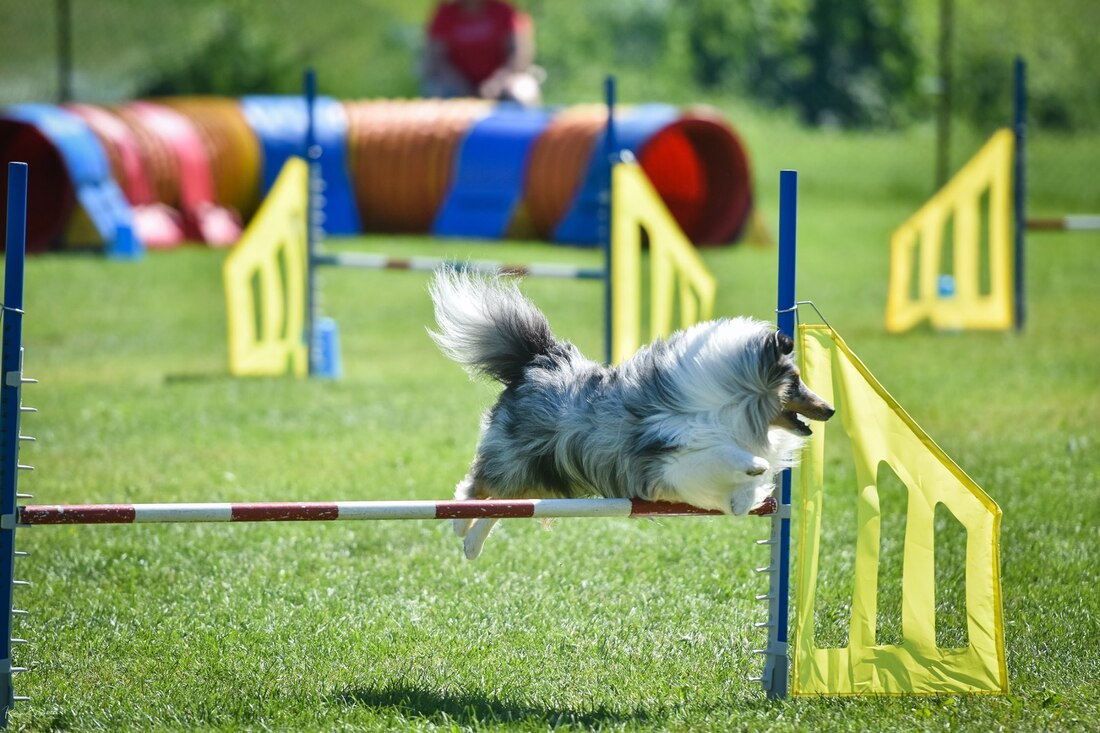|
As owners and trainers we're highly attuned to the movement of our dog's tail. But have you ever really looked at your dog's tail? Chance are, in the middle of a sport performance the last thing your doing is looking at your dog's tail but you may be surprised to see just how big of a role it plays! It's easy to forget that our dog's tail is a vital part of our dog's sport performance and everyday life. Our dog's have an extra appendage that is highly flexible and capable of complex movements to convey information and complete challenging physical movements. Put simply, our dog's tail is an important physical and emotional part of their body. In this week's blog we'll take a look at how the tail helps a sporting performance and the potential ways a tail can be injured. Anatomy of a TailLike our dogs, tails come in all shapes and sizes. Our dog's tails have evolved over time to suit the demands of their environment and the work we ask them to do. In retrieving breeds, you'll often see tails that are thick and rudder-like to help with navigating in the water. Nordic breeds, like huskies and malamutes, often have soft and bushy tails, perfect for a cold winters nights. While breeds like the greyhound have long thing tails to assist in running and some breeds have their tail docked at a young age. Regardless of the type of tail your dog has there are a few anatomical factors to be aware of. The tail of our dogs is the very end of their vertebral column and is the hindmost part of the backbone. There is usually six to twenty-three highly mobile vertebrea in a dog's tail. Like the spinal column, each of these vertebrae are enclosed by muscle that allows for fine movements that lift the tail, move it side to side, or lower to tuck under the bum and between the legs. Additionally, the muscles and nerves found in the tail also contribute to bowel control and movement. Docked TailsIn some breeds, like the Weimaraner, Australian Shepherd, German Shorthaired pointer, and Boxer, docking is a common practice. In fact, over 60 breed standards call for the docking of tails. Docking refers to the surgical removal of puppies tail, usually performed at 2-5 days of age. This procedure cuts across caudal coccygeal vertebrae, nerves and muscles of the tail. The practice started for a couple of reasons. Historically, the first instance of docking tails occurred in ancient Rome where it was believed that removing the top of a dog’s tail on the “puppy’s fortieth day” prevented rabies. In the 18th century, a tax was placed on dog ownership; hunting dogs where the exempt from the tax. To distinguish hunting dogs, wealthy owners docked their tail, this subsequently led to owners in the lower classes and poor social standing to also dock their dog's tails to avoid taxation (Fleming 1895). The other reason tails are docked is to prevent injury, particularly with working breeds. Some believe that a long tail can be dangerous for working dogs. Common justification for preventive docking is that guard dogs could be seized by the tail, hunting dogs could be injured or have long haired tails snared in the brush. However, most tail docking today is done due to breed tradition. Research into docking has found that preventative docking for both pet and working dogs is an unnecessary procedure and increasingly docking is viewed more as a cosmetic rather than functional procedure (Diesel 2010, Darke 1985). In some European countries, where docking is illegal, breed standard have been altered to allow for a full tail. The way a tail is docked can very significantly across breeds depending on what the standard calls. For example, the standard for Rottweilers calls for only two vertebrae in the tail while in the Weimaraner docking calls for tails to be roughly 6 inches when the dog is grown. Docking can be performed by a veterinarian but is commonly done by breeders using a pair of scissors or caused to drop off by occluding the blood supply using a tight rubber band. How our dog's use their tails.... As the dog comes out of the weave and is making a quick turn note how his tail is acting as a counterweight and indicates the direction he his heading. (Rookie owned by Deb Hegg) As the dog comes out of the weave and is making a quick turn note how his tail is acting as a counterweight and indicates the direction he his heading. (Rookie owned by Deb Hegg)
A tale of a unfortunate event... Post-amputation (Photo by Kayla Grant) Post-amputation (Photo by Kayla Grant) Because tails are an extremity, they can be vulnerable to injury from blunt force trauma and from accidents involving slammed doors or mis-steps. These injuries can be relatively minor but freak accidents resulting in more serious injuries can occur. A couple months ago, one of the MCR staff dogs Valor, a 5-year-old Alaskan Klee Kai, suffered a traumatic injury to his tail. Valor was laying on his dog bed when a member of his family accidentally stepped on the hair of his tail. Valor, being a calm, cool, and collected individual immediately yelped and ran away – degloving the very tip of his tail and exposing less than an inch of tail bone. While at first glance only the tip of the tail was affected the exposed bone resulted in a recommendation from vets to amputate part of his tail. In order to get enough skin to be able to stitch the wound closed Valor ended up losing roughly half his tail! Dogs with short or docked tails can still be balanced, especially if they have had a short tail since puppyhood. Dogs with docked tail grow up using the body they have and are accustom to the physical demands placed on their body. Dogs who, like Valor, lost a part or all of their tail due to injury and trauma will have a harder time adapting and will have to relearn some skills. To assist in adapting to these physical changes it's advisable to introduce conditioning work so that the dog can learn in a safe environment how their tail loss will effect their movement. Exercises which focuses on proprioception and balance are key to this relearning process. As a dog familiar with conditioning work, Valor was able to quickly adapt to his shortened tail and was back doing the things he loved shortly after his surgery. Common injuries to the tailWhile traumatic injuries like Valor experienced is rare there are a number of other injuries tails can experience which I'll cover here...
Some common questions...Q: My dog doesn't have a tail. How will that effect their body and sport performance? A: As the tail is an important counterbalance for tight turns, a dog with a shorted or absent tail may experience increased compensation issues and pressure in their spine. Conditioning work that focuses on the core and spine stabilization will help compensate for added workload. Q: My dog had an injury resulting in amputation, what do I do? A: First, you'll have to let the tail heal! Follow the guidance of your vet for when they can safely return to exercise. Once your dog is cleared to exercise start implementing balance exercises, like weight shifting and body awareness workouts. Q: My dog's tail looks broken after a day swimming? A: Chances are your dog may be suffering from swimmers tail ( acute caudal myopathy). While the cause of swimmer's tail is unknown, it most commonly occurs to dogs who spend a lot of time swimming, especially in cold water - this is why it's commonly called swimmers tail, dead tail, or cold tail! When swimming, dogs use their tail to help balance and steering, which can overexert the muscles. This type of injury affects the base of the tail and can be recognized by a tail that is flaccid or held horizontally for 3 to 4 inches, and then drops vertically. The dog may exhibit pain if you try to manipulate the base of the tail. Treatment usually requires rest and can the time it takes to recover can take anywhere from a day to 2-3 weeks to heal. Q: Can laser therapy help my dog's tail? A: Yes! If you dog has a wound on their tail or is suffering from acute caudal myopathy laser therapy can help speed the healing process! The use of light energy on affected tissues can help decrease swelling, pain, and nerve inflammation, as well as decrease muscle spasms, break down scar tissue, and promote wound healing. Your dog's tail can clue you into a lot of different issues both physically and emotionally. A useful exercise is to flip through some of your old competition photos (or film a slow motion video!) and examine how their tail carriage is. This is a great way to see how the tail functions in sport and you may be surprised to see just how in tune your dog's body is to their needs! Remember, the tail is an important appendage of your dog's body and should receive the same care and attention as other parts of their body! SourcesDarke PG, Thrusfield MV, Aitken CG. "Association between tail injuries and docking in dogs." Vet Rec 1985;116:409
Diesel G, Pfeiffer D, Crispin S, et al. "Risk factors for tail injuries in dogs in Great Britain." Vet Rec 2010;166:812-817. Fleming. "The wanton mutilation of animals." The Nineteenth Century, a Monthly Report, 1895;37:440. Ihrke, Amber. "The Prevalence of Spondylosis Deformans in Tail-Less Rottweilers and its Association with Cranial Cruciate Ligament Insufficieny." Presentation (Feb 2018) Mellor, David J. "Tail Docking of Canine Puppies: Reassessment of the Tail’s Role in Communication, the Acute Pain Caused by Docking and Interpretation of Behavioural Responses." Animal Welfare Science and Bioethics Centre, 2018; 8:82. Steiss, Jan E. "What is Limber Tail Syndrome?" Scott-Ritchey Research Center, 1997; (5-6):1
0 Comments
Leave a Reply. |
AuthorCarolyn McIntyre Archives
June 2024
Categories
All
|


 RSS Feed
RSS Feed